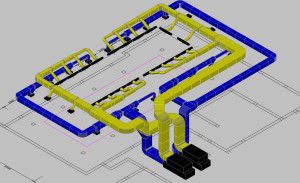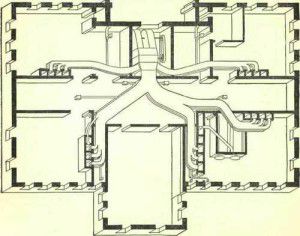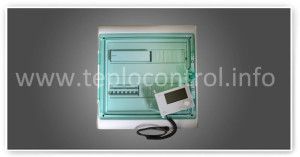An illiterate design of a ventilation system is a wasted effort, time and money. When drawing up a ventilation project for a room, you need to carefully approach the little things. A consultation with a professional will not be superfluous. Using your knowledge and our tips, you can create a ventilation project with your own hands. The purpose of the ventilation project is to select and equip equipment for a particular private house or apartment. Any project consists of graphic and design parts.
Ventilation type selection
Before you begin to make a ventilation project, you need to decide on the type of system suitable for your apartment or cottage.
There are three types of ventilation:
- natural;
- mechanical;
- combined.
Natural ventilation is present in most multi-story buildings. Air is supplied through the slots of windows and doors, outflow through ventilation vents and shafts in the kitchen and in the bathroom, the project of which exists with the developer.
Some owners want to mechanize the outflow of air and then a project for exhaust ventilation of the apartment is required. Air discharge is provided from the most polluted and wet areas: the kitchen (and especially the hob), the bathroom. In the project for exhaust ventilation, it is necessary to indicate the cross section of the ducts, their direction, power and location of the exhaust fan.
It is important not only to correctly calculate the system components, but also to harmoniously integrate the project into the kitchen with a ventilation shaft, corners and corners.
Creating a project for ventilation of an apartment or a cottage with a mechanical draft of the inflow-blowing system requires special knowledge. Typically, a project to produce ventilation work in such cases is ordered by specialists.
Ventilation design steps
-
Creation of a general scheme (preliminary example) of a ventilation project;
- Development of a detailed sketch of the placement of equipment, ducts and communications, an explanatory note to the ventilation project;
- Calculations of heat gain and air exchange;
- Feasibility study or explanatory note to the ventilation project;
- Creation of the final version of the ventilation project.
What you need to know for ventilation design
Before making a project for ventilation of an apartment, it is necessary to deal with an existing system in the house. For example, if you create a kitchen project with an exhaust shaft, you need to equip the supply air ventilation supplying fresh air.
The project of ventilation of a private house must comply with the requirements of firefighters, sanitary inspection, and also, be economical and appropriate.
Next, we provide a list of data without which it is impossible to draft a ventilation system:
- The volume of each of the premises of the house;
- The location of the premises and the purpose of each of them. This is important information that affects the rate of air exchange. Multiplicity indicators according to GOST and SNiP we give below. If the premises will be used for storing odorous or volatile substances, special requirements are imposed on the ventilation design. So, the hood is installed stronger than the influx to avoid the flow of odors into neighboring rooms;
- Counting the number of diffusers in each room and air flow for each. Exhaust air is most often diverted through the ceiling and roof or through the wall.
Now you have enough information to build a network of ducts between diffusers or anemostats, that is, mechanisms that allow air to pass into or out of rooms.
At this stage, the aerodynamic calculation of the system is done.
When diffusers are indicated in the ventilation project of a private house, a duct route is planned, it must be compared with the project of the house itself.
Where are the supporting structures, beams, floors, walls and arches. What are the ceilings planned and how to hide the air ducts, air handling unit and fans. You can consult a professional regarding the location of holes in the supporting structures. Only after this can you take the example of a ventilation project as final.
Keep in mind: the ventilation system is an off-the-shelf and very accurate design. It is not possible to change the cross-section of air ducts, add fans or ventilation grilles.
Any changes made completely violate the aerodynamics in the system. An extra turn - and the air will simply not reach the last in the room chain. Therefore, save your money and take responsibility for design.
A good supply and exhaust ventilation project takes into account the order of installation of communications. For example, you have planned a duct, and plumbers have piped water in this place. So the problem is that it takes time to transfer communications, extra money is being spent. The error is precisely in the design of ventilation. Therefore, not everyone will take up this difficult matter with their own hands.
For some rooms it is necessary to design separate ventilation. For example, the hood from the toilet and the bathroom cannot go into the common exhaust duct.
One of the most important points in the design of a ventilation system is the location of the exhaust and supply units. This is quite noisy equipment, so it is important to remove it away from living quarters or choose the quietest model.
Design calculations for ventilation
The first calculation for drawing up a ventilation project is the volume of ventilated rooms. It is done according to the formula:
width * length * ceiling height
Aerodynamic calculations are one of the most important design stages, on which the effectiveness of future ventilation of an apartment depends. It is necessary to calculate the cross-sectional area of the ducts and their resistance to air flow. The resistance of filters, adapters, turns and ducts themselves is also taken into account. On the basis of which the resistance of the entire system is determined. Do not forget about the air ducts located before the air supply unit and behind the fan, they also create resistance.
The project of supply and exhaust ventilation is necessarily based on the calculation of heat influx. Internal and external heat sources are taken into account. For calculating external heat inflows, standard tables with standards for each region are used. Heat gain in the cold season is negative, and in the warm - positive. Internal heat inflows are provided by the residents of the house, household appliances and are never negative.
Heat gain is necessary for calculating air exchange - an important indicator of ventilation. The air exchange rate is also taken into account:
- in living rooms 4 – 8;
- in the kitchen and bathroom 10 – 30;
- indoor pool 4 – 6.
Air flow per tenant in cubic meters per hour:
- living rooms 35 – 55;
- kitchen 65 – 85;
- gym, pool 85.
Calculation of the distribution of air when designing ventilation with your own hands includes:
- method of supply and discharge (bottom or top);
- distribution method (crowding out or mixing);
- type of air supply (flat or flooring jet, fan);
- type and number of diffusers.
You carefully worked out the scheme of air channels, coordinated it with the design of the building. Having determined the resistance of each section and the air flow, you get a "working point" for the system. For example, 1500 cu. meters and 700 Pa.Under these indicators, a supply unit or a fan is purchased that provides air exchange in the apartment. When designing the supply and exhaust ventilation, it is necessary to take into account the resistance of heaters, filters, humidifiers, coolers and other components.
More information about the calculated part of the ventilation project in the video:
Ventilation Automation Project
As a rule, residents of private houses do not face the need to create a ventilation automation project. Automation is installed on large industrial systems and its purpose is to coordinate and monitor the operation of various nodes. A ventilation automation controller connects dozens of sensors. The project provides for automatic control of dampers, fans, air heaters. According to the ventilation automation project, the main control unit is an automation cabinet. When developing a project for ventilation of an apartment or a cottage, it is necessary to carefully consider the location of the equipment control panel. It should be affordable and safe.







